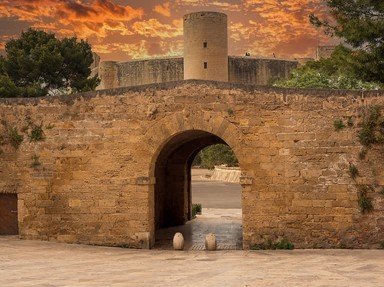Quiz Answer Key and Fun Facts
1. Although there are remnants of earlier walls as far west as Lop Nur, a dried-up salt lake that is now mined for potash, the western end of the Ming Dynasty Wall is generally considered to be at Jiayuguan Fort, shown here. The ending -guan on the name of this location means that the fort is in what type of geographical location, one with obvious strategical value?
2. The first stretch of the Wall on the western end extends through the Gansu Corridor, which is part of what famed travel route?
3. At the eastern end of the Gansu Corridor, the Wall continues eastward along the southern edge of the Ordos Desert, instead of following the more obviously strategic route along a major river that loops up and around the desert. Which of China's major rivers was neglected when this stretch of the fortification was constructed?
4. When the Wall reaches Piantou Pass to the east of the Ordos Desert, it splits into two branches. Which branch should we follow if we want to see Yanmen Pass, in the picture?
5. If you visit Beijing, you will probably take the time to travel 80 km (50 mi) northwest to walk along the first section to be opened to the public, the Badaling Great Wall. How was this portion of the Wall involved in the 2008 Beijing Olympics?
6. Badaling Wall is at the northern end of Juyongguan (Juyong Pass). In the middle of the valley is a famous structure called the Cloud Platform gate, seen on the left side of the picture. What was its (somewhat surprising) original purpose when it was constructed in the 14th century?
7. Mutianyu Great Wall connects Juyong Pass and Gubeikou Pass, extending a bit over two kilometers. What is unusual about the structure of this stretch of wall?
8. Next we proceed to the Jinshanling Wall, one of the best-preserved stretches of the wall. Over the course of 10 km, it crosses five passes and has nearly 70 watchtowers. The view from inside one of these towers is shown in the photo. These towers served many purposes - which of these was NOT one of their primary functions?
9. About 120 km northeast of Beijing, the Simatai Great Wall runs for about five km and is known for which feature?
10. Here we see what is usually considered to be the eastern end of the Great Wall, where it meets the Bohai Gulf. (Because there are so many pieces of Wall constructed at various times over the centuries, several other spots claim to be the eastern terminus, as well.) What name is given to the portion of the Wall, shown here, which extends into the sea?
Source: Author
looney_tunes
This quiz was reviewed by FunTrivia editor
trident before going online.
Any errors found in FunTrivia content are routinely corrected through our feedback system.

